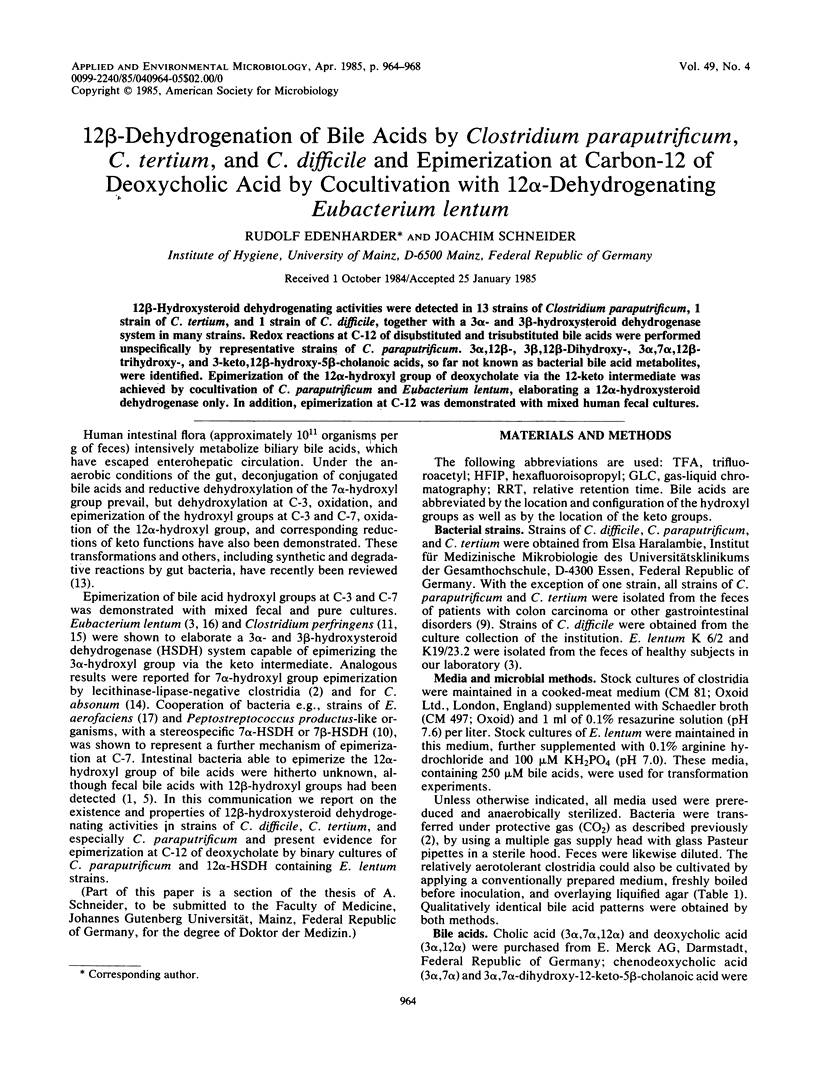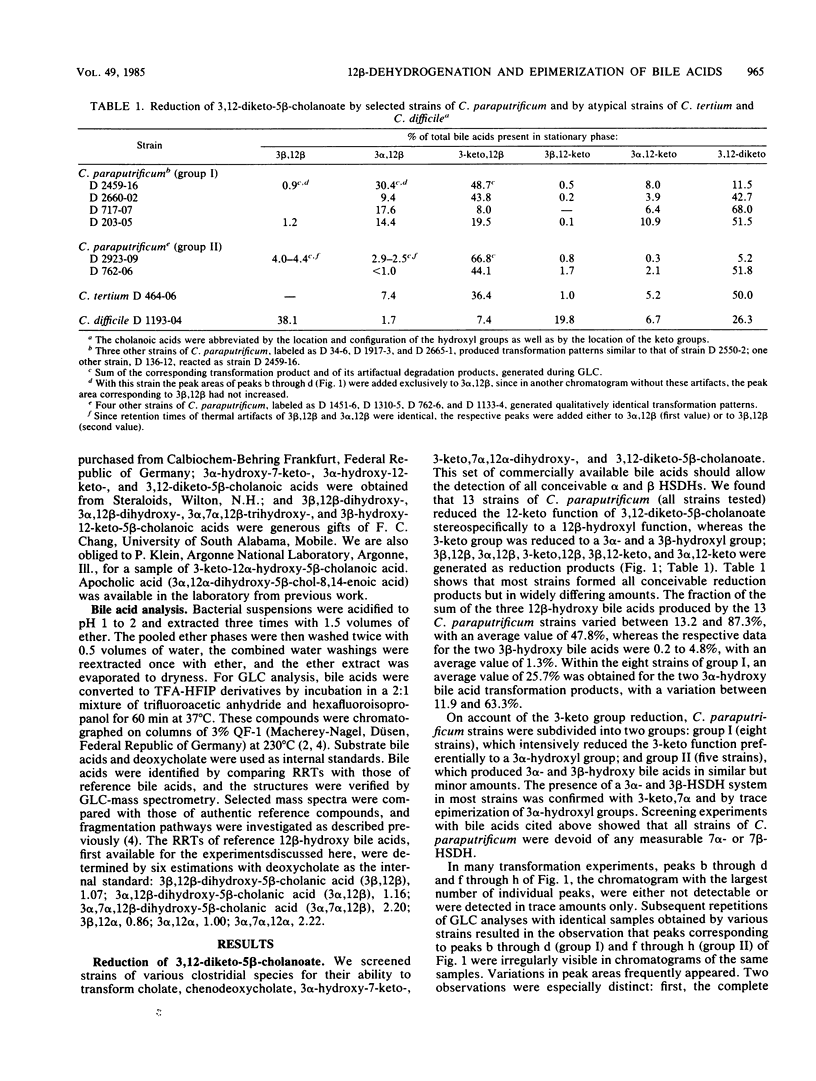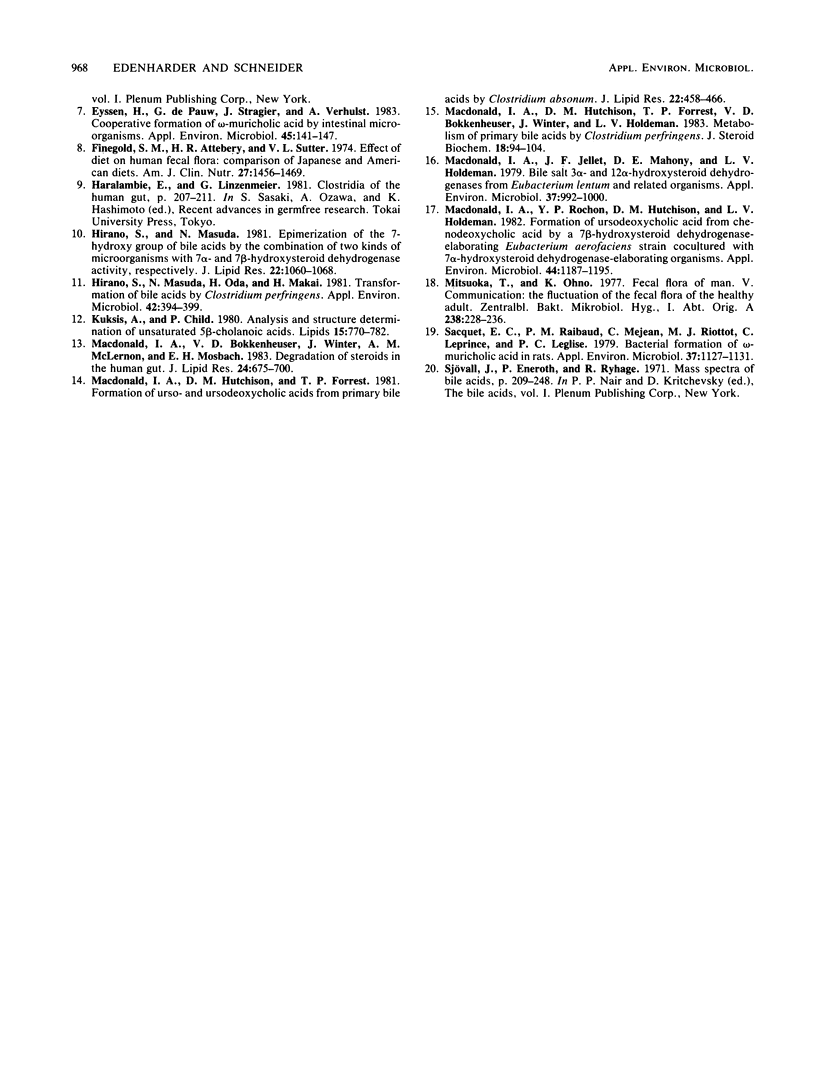Abstract
12 beta-Hydroxysteroid dehydrogenating activities were detected in 13 strains of Clostridium paraputrificum, 1 strain of C. tertium, and 1 strain of C. difficile, together with a 3 alpha- and 3 beta-hydroxysteroid dehydrogenase system in many strains. Redox reactions a C-12 of disubstituted and trisubstituted bile acids were performed unspecifically by representative strains of C. paraputrificum. 3 alpha,12 beta-, 3 beta,12 beta-Dihydroxy-, 3 alpha, 7 alpha, 12 beta-trihydroxy-, and 3-keto,12 beta-hydroxy-5 beta-cholanoic acids, so far not known as bacterial bile acid metabolites, were identified. Epimerization of the 12 alpha-hydroxyl group of deoxycholate via the 12-keto intermediate was achieved by cocultivation of C. paraputrificum and Eubacterium lentum, elaborating a 12 alpha-hydroxysteroid dehydrogenase only. In addition, epimerization at C-12 was demonstrated with mixed human fecal cultures.
Full text
PDF




Selected References
These references are in PubMed. This may not be the complete list of references from this article.
- Ali S. S., Kuksis A., Beveridge J. M. Excretion of bile acids by three men on corn oil and butterfat diets. Can J Biochem. 1966 Oct;44(10):1377–1388. doi: 10.1139/o66-156. [DOI] [PubMed] [Google Scholar]
- Edenharder R., Knaflic T. Epimerization of chenodeoxycholic acid to ursodeoxycholic acid by human intestinal lecithinase-lipase-negative Clostridia. J Lipid Res. 1981 May;22(4):652–658. [PubMed] [Google Scholar]
- Eneroth P., Gordon B., Ryhage R., Sjövall J. Identification of mono- and dihydroxy bile acids in human feces by gas-liquid chromatography and mass spectrometry. J Lipid Res. 1966 Jul;7(4):511–523. [PubMed] [Google Scholar]
- Eyssen H., De Pauw G., Stragier J., Verhulst A. Cooperative formation of omega-muricholic acid by intestinal microorganisms. Appl Environ Microbiol. 1983 Jan;45(1):141–147. doi: 10.1128/aem.45.1.141-147.1983. [DOI] [PMC free article] [PubMed] [Google Scholar]
- Finegold S. M., Attebery H. R., Sutter V. L. Effect of diet on human fecal flora: comparison of Japanese and American diets. Am J Clin Nutr. 1974 Dec;27(12):1456–1469. doi: 10.1093/ajcn/27.12.1456. [DOI] [PubMed] [Google Scholar]
- Hirano S., Masuda N. Epimerization of the 7-hydroxy group of bile acids by the combination of two kinds of microorganisms with 7 alpha- and 7 beta-hydroxysteroid dehydrogenase activity, respectively. J Lipid Res. 1981 Sep;22(7):1060–1068. [PubMed] [Google Scholar]
- Hirano S., Masuda N., Oda H., Mukai H. Transformation of bile acids by Clostridium perfringens. Appl Environ Microbiol. 1981 Sep;42(3):394–399. doi: 10.1128/aem.42.3.394-399.1981. [DOI] [PMC free article] [PubMed] [Google Scholar]
- Kuksis A., Child P. Analysis and structure determination of unsaturated 5 beta - cholanoic acids. Lipids. 1980 Sep;15(9):770–782. doi: 10.1007/BF02534031. [DOI] [PubMed] [Google Scholar]
- MacDonald I. A., Jellett J. F., Mahony D. E., Holdeman L. V. Bile salt 3 alpha- and 12 alpha-hydroxysteroid dehydrogenases from Eubacterium lentum and related organisms. Appl Environ Microbiol. 1979 May;37(5):992–1000. doi: 10.1128/aem.37.5.992-1000.1979. [DOI] [PMC free article] [PubMed] [Google Scholar]
- MacDonald I. A., Rochon Y. P., Hutchison D. M., Holdeman L. V. Formation of ursodeoxycholic acid from chenodeoxycholic acid by a 7 beta-hydroxysteroid dehydrogenase-elaborating Eubacterium aerofaciens strain cocultured with 7 alpha-hydroxysteroid dehydrogenase-elaborating organisms. Appl Environ Microbiol. 1982 Nov;44(5):1187–1195. doi: 10.1128/aem.44.5.1187-1195.1982. [DOI] [PMC free article] [PubMed] [Google Scholar]
- Macdonald I. A., Bokkenheuser V. D., Winter J., McLernon A. M., Mosbach E. H. Degradation of steroids in the human gut. J Lipid Res. 1983 Jun;24(6):675–700. [PubMed] [Google Scholar]
- Macdonald I. A., Hutchison D. M., Forrest T. P., Bokkenheuser V. D., Winter J., Holdeman L. V. Metabolism of primary bile acids by Clostridium perfringens. J Steroid Biochem. 1983 Jan;18(1):97–104. doi: 10.1016/0022-4731(83)90336-9. [DOI] [PubMed] [Google Scholar]
- Macdonald I. A., Hutchison D. M., Forrest T. P. Formation of urso- and ursodeoxy-cholic acids from primary bile acids by Clostridium absonum. J Lipid Res. 1981 Mar;22(3):458–466. [PubMed] [Google Scholar]
- Mitsuoka T., Ono K. Die Faekalflora bei Menschen. V. Mitteilung: Die Schwankungen in der Zusammensetzung der Faekalflora gesunder Erwachsener. Zentralbl Bakteriol Orig A. 1977 Jun;238(2):228–236. [PubMed] [Google Scholar]
- Sacquet E. C., Raibaud P. M., Mejean C., Riottot M. J., Leprince C., Leglise P. C. Bacterial formation of omega-muricholic acid in rats. Appl Environ Microbiol. 1979 Jun;37(6):1127–1131. doi: 10.1128/aem.37.6.1127-1131.1979. [DOI] [PMC free article] [PubMed] [Google Scholar]


